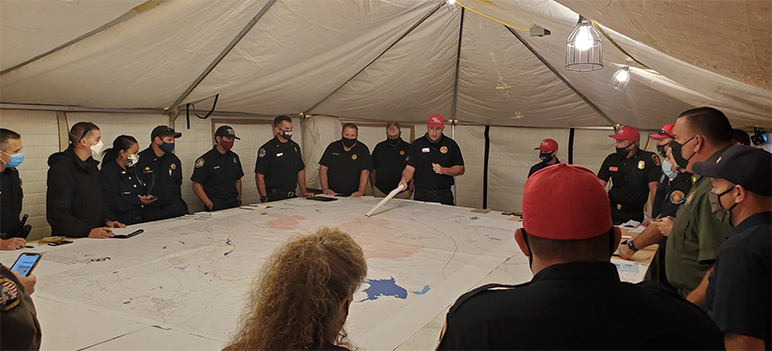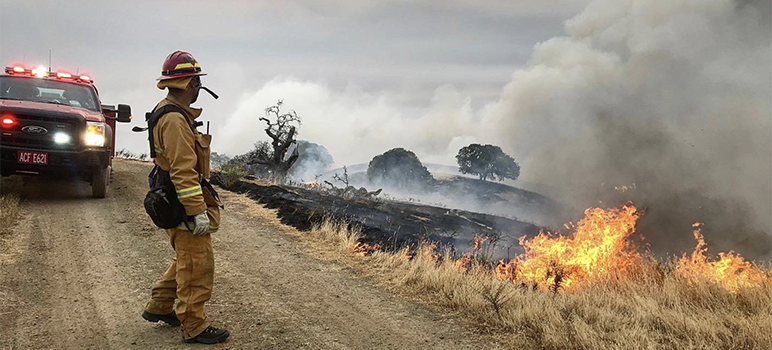Wildfires east of Santa Clara Valley have burned through nearly 300,000 acres, Cal Fire announced early this morning. That makes the SCU Complex the second-largest burning in California and the third-largest in the state’s recorded history.
Just 10 percent of the blazes known as the SCU Complex are under control after consuming 291,968 acres—and counting—by 7am today in Santa Clara, Contra Costa, Alameda, Stanislaus and San Joaquin counties.

Cal Fire briefs personnel from myriad local agencies on the fire weather forecast today. (Photo via Cal Fire)
Two firefighters and two civilians have been hurt by the cluster of blazes, according to Cal Fire, and five buildings have been destroyed.
Still 20,000 more structures remain threatened.
The SCU Complex—one of three major groups of fires scorching the Bay Area this week—started as 20 separate lightning-struck blazes on Sunday and have since morphed into a few bigger blazes broken into three distinct areas. Cal Fire said the SCU Complex now comprises the Canyon Zone, Calaveras Zone and Deer Zone.
#SCULightningComplex | Incident Update | 8.22.20 7 AM pic.twitter.com/LCTvIZr4ay
— CAL FIRE SCU (@calfireSCU) August 22, 2020
Thankfully, nightfall brought some humidity in lower elevations, which somewhat slowed the fires’ spread, officials said in the most recent incident update.
However, high clouds formed by tropical moisture are headed northward, perhaps a sign of storms ahead, according to the National Weather Service, which predicts dry lightning on Sunday and through early next week.
“Expect an increase in fire activity when the inversion lifts and smoke clears the area today,” Cal Fire cautioned in today’s incident report. “The protection of sensitive wildlife and critical power and communication infrastructure remains a top priority.”
Evacuations remain in effect for the areas east of San Jose and Morgan Hill. Click here to view the latest evacuation zones as mandated by Cal Fire.
If you have evacuated your home in Santa Clara County, and need assistance, go to the nearest Evacuation Resource Center:
Milpitas Library
160 N. Main Street
Milpitas, CA 95035Ann Sobrato High School
401 Burnett Ave.
Morgan Hill, CA 95037 pic.twitter.com/QTpgjOfvcs— Santa Clara County (@SCCgov) August 22, 2020
To the west of Santa Clara Valley, the CZU Complex of fires still rages, encroaching on more than 63,000 acres today with 5 percent containment from the Santa Cruz Mountains to the Peninsula. So far, more than 90 buildings have been destroyed and more than 60,000 people were ordered to evacuate.
A quick review from this morning's briefing. #CZULightningComplex pic.twitter.com/PYYcSgFViS
— CAL FIRE CZU (@CALFIRECZU) August 22, 2020
Up in the North Bay, the LNU Complex has exploded in size to 314,000 acres—once again exceeding the SCU Complex in scope to become the biggest fire in California.
Fifteen percent of the LNU is contained, four people injured, 560 structures destroyed and 125 buildings damaged, Cal Fire reported today.
#LNULightningComplex - Incident Update - 08.22.2020 7am - 1 of 2#CALFIRE#CALFIRELNU pic.twitter.com/X6LvNhVvon
— CAL FIRE LNU (@CALFIRELNU) August 22, 2020
Yet more than 30,000 structures remain threatened by the fires licking up vast swaths of Sonoma and Napa counties, where sweeping evacuation orders have forced tens of thousands of people to flee for safety.
Things are expected to get worse, officials said, predicting “significant fire growth” in the day ahead. “Extreme fire behavior with short and long range spotting are continuing to challenge firefighting efforts,” Cal Fire said in the LNU incident memo this morning. “Fires continue to make runs in multiple directions impacting multiple communities.”
Meanwhile, fires north of Lake Berryessa have merged into the Hennessy Fire and continue their “critical spread” in the direction of extremely flammable forests.
Smoke from the Northern California lightning fires has turned the regional air quality into some of the worst on the planet.
In the South Bay today, sunlight filters through a smoky haze that the Bay Area Air Quality Management District categorizes as a range of orange, meaning, “unhealthy for certain groups,” and red, which is unhealthy for most people.
To check the air quality in your specific area, click here.

